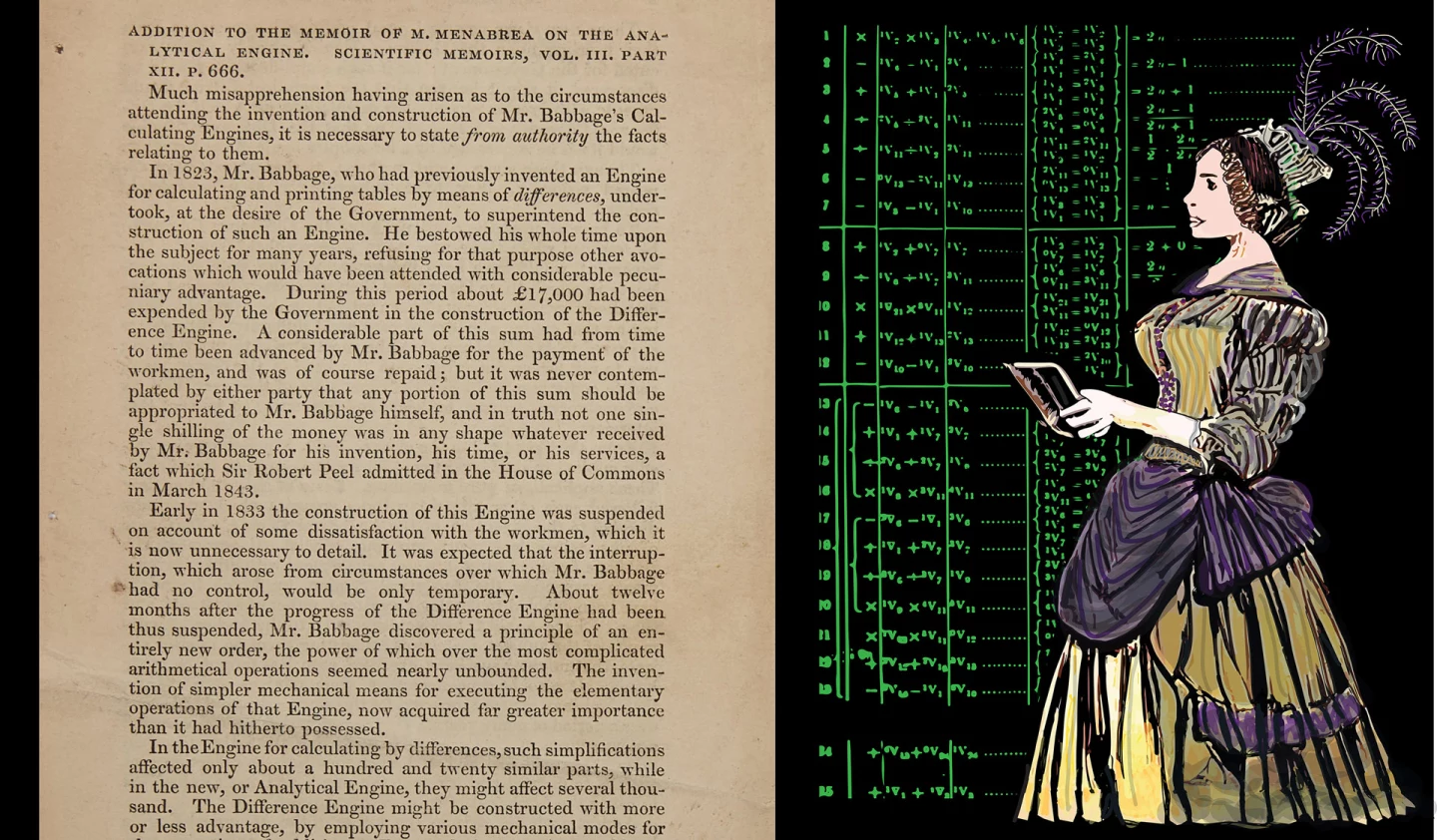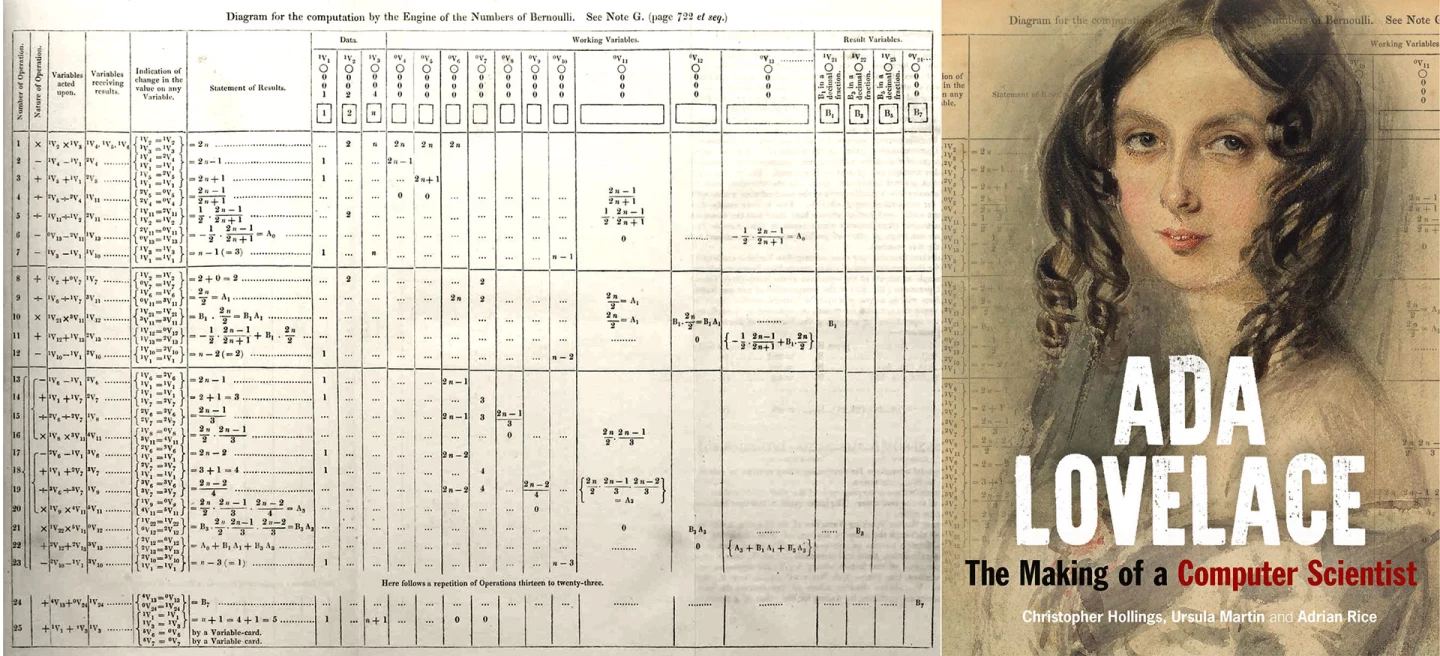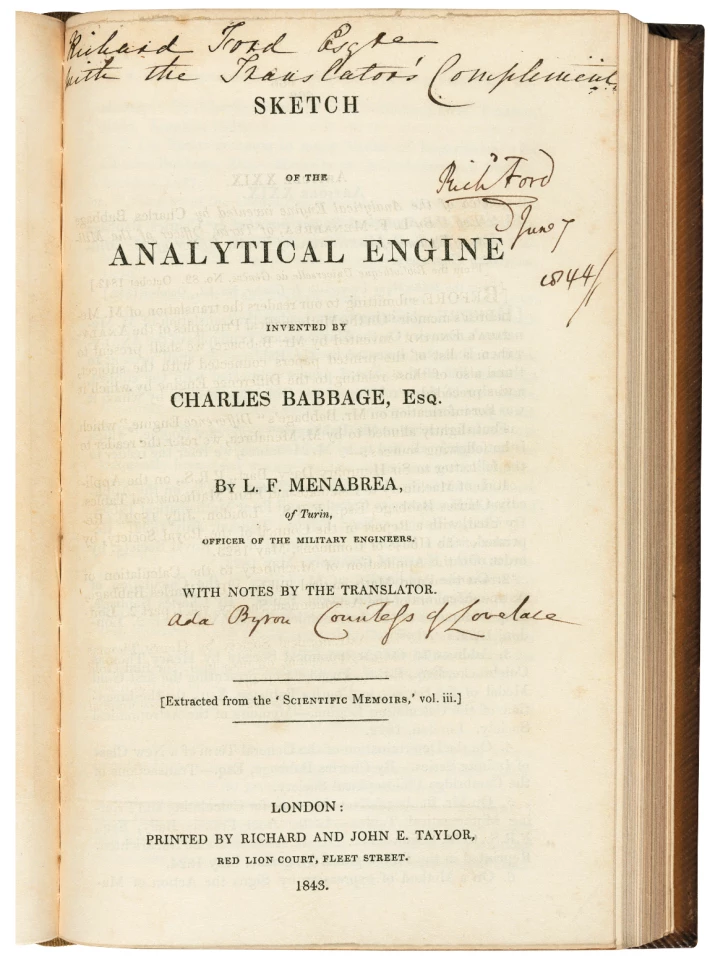Everyone acknowledges the massive impact of the digital revolution upon every aspect of society, but auction prices for landmark digital memorabilia suggest we haven't got it all in perspective just yet. Here are five recent examples of historically important items that sold for a fraction of their worth.
Ada Lovelace's "Sketch of the Analytical Engine" (1843)

Women scientists are rare, particularly from more than 100 years ago. Women mathematicians who made a difference are even rarer. Augusta Ada King, Countess of Lovelace (known as Ada Lovelace) was the only legitimate child of the celebrated poet Lord Byron, though for most of the last 200 years, she didn't rate a mention alongside her prodigiously talented father.
The rise of the computer over the last 60 years though, has shed new light on her work with Charles Babbage on his proposed-but-not-built, general-purpose, mechanical computer, the Analytical Engine. Remarkably, her star has now risen above that of "Byron" and she has become one of the (previously unsung) giants of the computer age.

Ada Lovelace fell in love with numbers from an early age, thanks to being schooled in mathematics and the sciences, and her knowledge of advanced mathematics enabled her the opportunity to work with English polymath Charles Babbage. She became his assistant, but in the safety of her relationship with Babbage was able to become a collaborator of sorts, and in the fullness of time her intellect enabled her to see perhaps further into the future than anyone of her generation.
She added complementary skills to Babbage's ambitious but impoverished project, and is thought to have coined the frequently quoted analogy, 'We may say most aptly that the Analytical Engine weaves algebraic patterns just as the Jacquard-loom weaves flowers and leaves.'
Her explanations within this document are worth reading in the context of when they were written: "Many persons who are not conversant with mathematical studies, imagine that because the business of the engine is to give its results in numerical notation, the nature of its processes must consequently be arithmetical and numerical, rather than algebraical and analytical. This is an error. The engine can arrange and combine its numerical quantities exactly as if they were letters or any other general symbols; and in fact it might bring out its results in algebraical notation, were provisions made accordingly."

Though this was just 180 years ago, her identity in this work had to be obfuscated due to her gender. For a full five years after this paper was published, no-one but a central few knew the identity of "the translator."
This 1843 paper is a translation of an 1842 paper written by Italian mathematician Luigi Federico Menabrea (later to become the Prime Minister of Italy) and entitled "Notions sur la machine analytique de M. Charles Babbage." It was published in French in a Swiss Journal and was based on the lecture notes of a presentation Babbage had delivered in Turin in 1840. While incomplete and inaccurate, it served as the framework upon which Babbage & Lovelace could fully explain and publicise the project.
Lovelace translated the French to English, then added lengthy appendices and the result this essay being published in the September 1843 issue of the Philosophical Magazine - it now stands as the most important early paper on computing.
Copies of the original 1843 works have been sold for $280,776 in 2019, $170,500 in 2008, $125,000 in 2018, $100,000 in 2018, and $78,000 in 2005. Now copies are rare, and only a handful have reached public auction, but when the bidders run out, the hammer falls and sometimes a blue-chip bargain can be had. On 4 December 2019, a first edition journal issue of this paper sold for (USD) $15,075.
The first publication of Moore's Law

On 19 April 1965, Electronics magazine published an article which arguably changed the world more than any single act in history.
The article was written by Dr Gordon E. Moore, the Director of R&D at Fairchild Semiconductor and is generally regarded as the birth date of Moore's Law. This is where the exponential growth that drove the computer industry and changed the world in short order all started. This article is the reason most of the world's human inhabitants now carry a supercomputer in their pocket.
Moore's law is the observation that the number of transistors in an integrated circuit (IC) doubles about every two years. Moore's law might have begun as an observation but it soon became an historical trend that enrolled the Integrated Circuit manufacturers of the day to keep up or perish ... and catalysed truly exponential change.
Only a handful of copies of the magazine are extant. For those who worship at the shrine of the integrated circuit and its enabling of the most rapid technological advancements in history, Gordon Moore's article is where exponential growth of processing power became the norm. This is the point where Moore's Law began to assert an extraordinary influence on world history.
Moore's Law gave us the digital life that we look forward to getting up for each day.
For those not familiar with the story, Moore and Robert Noyce left Fairchild in 1968 and set up company called Intel (Integrated Electronics), now one of the largest companies in the world. Their first employee was Andy Grove.
In 2005, with Intel's 40th birthday looming, the company found it did not have an original copy of the magazine which included Moore's original article, and NEITHER DID HE. He loaned his original to someone and it never came back.
Intel duly posted a $10,000 reward for a copy of the magazine, which was finally claimed by a less-than-perfect specimen found under a house in a plastic bag in Northern England.
Magazines have a huge attrition rate, which makes them rarer than their original print run might suggest. When this copy came up in 2022, it was bound with a collection of other 1965 copies of Electronics magazine that had once been part of a University library. It is in perfect condition. Even tatty old copies of first editions of famous books sell for millions. One of two known first editions of "Moore's Law" outside of libraries sold for $6710 in 2022.
When tribal groups meet, their customs are often different. The tribe that grew up trading baseball cards and comics and video games decrees that the most valuable card specimens and comic specimens are those in the best condition, and for video games and cassettes, it's those that are still sealed from the factory.
Historic firsts such as this do not come shrink wrapped to begin with, and they are often in appalling condition, but it doesn't change what they are, being a monument to progress.
Moore's Law turns 60 on 19 April 2025.
It has wrought unprecedented change across every aspect of society, and ... it all began here.
The first quarter earned by the gaming industry

The tale of the beginning of the computer industry is well known, and perhaps best told by Walter Isaacson in his book "The Innovators." The jamming of the prototype "Pong" arcade machine in Andy Capp's Tavern was significant because it was the point at which Nolan Bushnell and Alan Alcorn knew they could self-fund Atari. In an environment where the average pinball machine generated $10 a day, Pong produced $40 a day. Game on! Quite literally.

The gaming industry is struggling at present thanks to the additional void left after the world forgot about COVID-19. Interest in games had peaked during COVID-19 as shelter-in-place rapidly spread across the world.
Auction prices for iconic video games went nuts.

When that wave of interest subsided more than expected post-COVID, it has left a much bigger hole than was anticipated and the games industry is hurting. It still pulls in well north of a billion dollars a day, it still dwarfs the movie and music industries, so it will return to growth and profitability in due course.
This was the first quarter the gaming industry earned - the one that jammed the Pong prototype in Andy Capp's Bar. It was mounted and presented to Alcorn by Nolan Bushnell. It sold at auction for $6,710 in 2022.
The birth of the internet

Two-thirds of the world's population now uses the internet, more than a million people connect for the first time every day, and there are 27 billion networked devices and 370 million domain names using the network.
It will eventually connect all of humanity.
There were plenty of networks prior to the internet, but they all operated with different hardware and software protocols, making it impossible for them to communicate with one another.
In 1973, two researchers (Vinton Cerf and Robert Kahn) put the final piece of the jigsaw puzzle in place when they proposed a new protocol that would enable interconnection and interoperability between different networks.
While doing this, they coined the term "internet", an abbreviation for their goal which was the "internetworking of networks." The solution involved a Transmission Control Protocol (TCP) that used unique identifiers (IP addresses) for each host on the network. It was subsequently split into two separate protocols - TCP for data transmission and IP for routing.
The TCP/IP protocol suite became the basis of the internet.
Vinton Cerf would later write: "Bob Kahn and I did the initial design of the Internet over the period from Spring to Fall, 1973. The paper ... was published in May 1974. By Nov 22, 1977 we had demonstrated a 3-network system using the TCP/IP protocols linking ARPANET, the Packet Radio Net and the Atlantic Packet Satellite net. By 1983 we launched the operational Internet (on January 1). By 1988, we knew it needed a commercial economic engine to drive growth and obtained permission to link the Internet to the commercial MCI Mail System. By 1989, three commercial Internet services were in operation: UUNET, PSINet and CERFNET."
The researchers published this paper entitled "A Protocol for Packet Network Intercommunication" in May, 1974. The paper is now extremely rare but ... considering the paper effectively gave birth to what may one day be seen as the greatest invention in history, it can be expected to be closely held and rare.
We can only find seven copies that have ever been to public auction.
The record price for the paper that gave birth to the internet was set in 2017 by Christie's at $32,500 (against an estimate of $12,000 to $18,000) with the second most valuable copy sold in 2008 at Christie's for $21,123. No other sale has gone above $10,000, with the two most recent sales being $9,800 in 2016 and $8,825 in 2019.
It's the closest thing there is to a birth certificate for the internet, and similar published works for landmark scientific breakthroughs sell at auction for two or three orders of magnitude more ... and you can't get any more LANDMARK than this paper.
We all acknowledge the contributions of Newton, Einstein, Crick/Watson ... but the luke-warm demand for one of the rarest and most important documents in world history is puzzling.
The internet will eventually connect all of humanity and it will be with us for eternity and its importance in the grand scheme of life on Earth has still not been recognised. The internet changed the world.
When the centenary of the internet comes around in 2077, and its monumental impact on society has some historical perspective, that $8,825 copy sold in 2019 could be worth more than a baseball card (current record $12.6 million).
The first computer mouse

The computer mouse is one of history's most important inventions, enabling the simplification of the Computer-Human-Interface (CHI) to such a degree that computer adoption became possible for everyone.
It is one of mankind's most prolific and useful inventions.
In 1968, one of the pioneers of the CHI delivered what is still known by the world's technophiles as "the mother of all demos."
In a 90-minute presentation to about 1,000 computer scientists at the Augmentation Research Center of Stanford Research Institute, Douglas Engelbart demonstrated video conferencing, screen sharing, email, hypertext, word processing, hypermedia, object addressing and dynamic file linking, bootstrapping, a collaborative real-time editor ... and the first mouse.
All of those things came to pass, but his invention of the mouse is the most tangible.
The first prototype Engelbart computer mouse we'd ever seen outside the grainy 1968 demo video went to auction in December 2020 and despite an estimate of just $800 (which our David Szondy thought would be "a massive bargain" in his preview of the event), it sold for $34,479, becoming the world's most expensive computer mouse and making news for its outrageous price.
In August 2021, two of Engelbert's three-button computer mice went to auction as one lot with the final price being $49,751. In March 2022, another Engelbart three-button X-Y Axis Mouse and coding keyset went to auction fetching $54,904 and in March 2023, yet another Engelbart three-button X-Y Axis Mouse and coding keyset went to auction and the importance of the devices finally began to be reflected in the auction price when it fetched $178,936.

There were less than 30 of those prototypes made and no-one has any idea how many are extant. My expectation is that at least 25 of them are out there, because the only people who got their hands on them were people who would have known its significance and had most likely been part of its creation at the Augmentation Research Center. Very few would have been thrown away. No doubt some hearts will be broken when they realise their pride and joy is now worth worth a quarter million and climbing and they'll need to sell it at that price.
If any more of these historic gems come to auction, expect prices to go much higher again. In terms of supply, 25 units seems to be the sweet spot to drive auction prices forever higher for any highly desirable object ... and any that have been shaken loose by the prospect of immediate high prices have probably gone now. If I owned one, I'd try to live longer, because the value of these original devices will increase with time.
Just three years ago, someone bought one of the first prototypes for one of the world's most successful enabling technologies ... for $35,000 ... these objects have a place in history which will be celebrated in 2028 as the Mouse turns 60 years-of-age and it turns 100 in 2068, by which time I'm betting they will still be used, at least in some circumstance. That $35,000 investment won't look like such a lot of money if any of these technological milestones reach auction that year.










